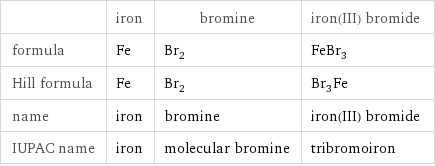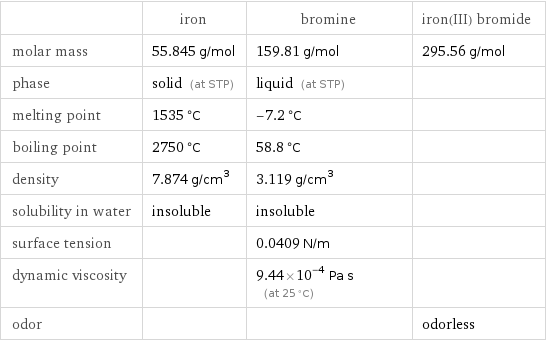Input interpretation

Fe iron + Br_2 bromine ⟶ FeBr_3 iron(III) bromide
Balanced equation

Balance the chemical equation algebraically: Fe + Br_2 ⟶ FeBr_3 Add stoichiometric coefficients, c_i, to the reactants and products: c_1 Fe + c_2 Br_2 ⟶ c_3 FeBr_3 Set the number of atoms in the reactants equal to the number of atoms in the products for Fe and Br: Fe: | c_1 = c_3 Br: | 2 c_2 = 3 c_3 Since the coefficients are relative quantities and underdetermined, choose a coefficient to set arbitrarily. To keep the coefficients small, the arbitrary value is ordinarily one. For instance, set c_1 = 1 and solve the system of equations for the remaining coefficients: c_1 = 1 c_2 = 3/2 c_3 = 1 Multiply by the least common denominator, 2, to eliminate fractional coefficients: c_1 = 2 c_2 = 3 c_3 = 2 Substitute the coefficients into the chemical reaction to obtain the balanced equation: Answer: | | 2 Fe + 3 Br_2 ⟶ 2 FeBr_3
Structures

+ ⟶
Names

iron + bromine ⟶ iron(III) bromide
Equilibrium constant
![Construct the equilibrium constant, K, expression for: Fe + Br_2 ⟶ FeBr_3 Plan: • Balance the chemical equation. • Determine the stoichiometric numbers. • Assemble the activity expression for each chemical species. • Use the activity expressions to build the equilibrium constant expression. Write the balanced chemical equation: 2 Fe + 3 Br_2 ⟶ 2 FeBr_3 Assign stoichiometric numbers, ν_i, using the stoichiometric coefficients, c_i, from the balanced chemical equation in the following manner: ν_i = -c_i for reactants and ν_i = c_i for products: chemical species | c_i | ν_i Fe | 2 | -2 Br_2 | 3 | -3 FeBr_3 | 2 | 2 Assemble the activity expressions accounting for the state of matter and ν_i: chemical species | c_i | ν_i | activity expression Fe | 2 | -2 | ([Fe])^(-2) Br_2 | 3 | -3 | ([Br2])^(-3) FeBr_3 | 2 | 2 | ([FeBr3])^2 The equilibrium constant symbol in the concentration basis is: K_c Mulitply the activity expressions to arrive at the K_c expression: Answer: | | K_c = ([Fe])^(-2) ([Br2])^(-3) ([FeBr3])^2 = ([FeBr3])^2/(([Fe])^2 ([Br2])^3)](../image_source/522932331721575236f6c157341888de.png)
Construct the equilibrium constant, K, expression for: Fe + Br_2 ⟶ FeBr_3 Plan: • Balance the chemical equation. • Determine the stoichiometric numbers. • Assemble the activity expression for each chemical species. • Use the activity expressions to build the equilibrium constant expression. Write the balanced chemical equation: 2 Fe + 3 Br_2 ⟶ 2 FeBr_3 Assign stoichiometric numbers, ν_i, using the stoichiometric coefficients, c_i, from the balanced chemical equation in the following manner: ν_i = -c_i for reactants and ν_i = c_i for products: chemical species | c_i | ν_i Fe | 2 | -2 Br_2 | 3 | -3 FeBr_3 | 2 | 2 Assemble the activity expressions accounting for the state of matter and ν_i: chemical species | c_i | ν_i | activity expression Fe | 2 | -2 | ([Fe])^(-2) Br_2 | 3 | -3 | ([Br2])^(-3) FeBr_3 | 2 | 2 | ([FeBr3])^2 The equilibrium constant symbol in the concentration basis is: K_c Mulitply the activity expressions to arrive at the K_c expression: Answer: | | K_c = ([Fe])^(-2) ([Br2])^(-3) ([FeBr3])^2 = ([FeBr3])^2/(([Fe])^2 ([Br2])^3)
Rate of reaction
![Construct the rate of reaction expression for: Fe + Br_2 ⟶ FeBr_3 Plan: • Balance the chemical equation. • Determine the stoichiometric numbers. • Assemble the rate term for each chemical species. • Write the rate of reaction expression. Write the balanced chemical equation: 2 Fe + 3 Br_2 ⟶ 2 FeBr_3 Assign stoichiometric numbers, ν_i, using the stoichiometric coefficients, c_i, from the balanced chemical equation in the following manner: ν_i = -c_i for reactants and ν_i = c_i for products: chemical species | c_i | ν_i Fe | 2 | -2 Br_2 | 3 | -3 FeBr_3 | 2 | 2 The rate term for each chemical species, B_i, is 1/ν_i(Δ[B_i])/(Δt) where [B_i] is the amount concentration and t is time: chemical species | c_i | ν_i | rate term Fe | 2 | -2 | -1/2 (Δ[Fe])/(Δt) Br_2 | 3 | -3 | -1/3 (Δ[Br2])/(Δt) FeBr_3 | 2 | 2 | 1/2 (Δ[FeBr3])/(Δt) (for infinitesimal rate of change, replace Δ with d) Set the rate terms equal to each other to arrive at the rate expression: Answer: | | rate = -1/2 (Δ[Fe])/(Δt) = -1/3 (Δ[Br2])/(Δt) = 1/2 (Δ[FeBr3])/(Δt) (assuming constant volume and no accumulation of intermediates or side products)](../image_source/685c98057b28684b905b213b31e3d322.png)
Construct the rate of reaction expression for: Fe + Br_2 ⟶ FeBr_3 Plan: • Balance the chemical equation. • Determine the stoichiometric numbers. • Assemble the rate term for each chemical species. • Write the rate of reaction expression. Write the balanced chemical equation: 2 Fe + 3 Br_2 ⟶ 2 FeBr_3 Assign stoichiometric numbers, ν_i, using the stoichiometric coefficients, c_i, from the balanced chemical equation in the following manner: ν_i = -c_i for reactants and ν_i = c_i for products: chemical species | c_i | ν_i Fe | 2 | -2 Br_2 | 3 | -3 FeBr_3 | 2 | 2 The rate term for each chemical species, B_i, is 1/ν_i(Δ[B_i])/(Δt) where [B_i] is the amount concentration and t is time: chemical species | c_i | ν_i | rate term Fe | 2 | -2 | -1/2 (Δ[Fe])/(Δt) Br_2 | 3 | -3 | -1/3 (Δ[Br2])/(Δt) FeBr_3 | 2 | 2 | 1/2 (Δ[FeBr3])/(Δt) (for infinitesimal rate of change, replace Δ with d) Set the rate terms equal to each other to arrive at the rate expression: Answer: | | rate = -1/2 (Δ[Fe])/(Δt) = -1/3 (Δ[Br2])/(Δt) = 1/2 (Δ[FeBr3])/(Δt) (assuming constant volume and no accumulation of intermediates or side products)
Chemical names and formulas

| iron | bromine | iron(III) bromide formula | Fe | Br_2 | FeBr_3 Hill formula | Fe | Br_2 | Br_3Fe name | iron | bromine | iron(III) bromide IUPAC name | iron | molecular bromine | tribromoiron
Substance properties

| iron | bromine | iron(III) bromide molar mass | 55.845 g/mol | 159.81 g/mol | 295.56 g/mol phase | solid (at STP) | liquid (at STP) | melting point | 1535 °C | -7.2 °C | boiling point | 2750 °C | 58.8 °C | density | 7.874 g/cm^3 | 3.119 g/cm^3 | solubility in water | insoluble | insoluble | surface tension | | 0.0409 N/m | dynamic viscosity | | 9.44×10^-4 Pa s (at 25 °C) | odor | | | odorless
Units
